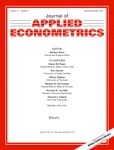
Hochguertel, S. (2004). Precautionary Motives and Portfolio Decisions Journal of Applied Econometrics, 18:61--77.
-
Affiliated author
-
Publication year2004
-
JournalJournal of Applied Econometrics
This paper studies the empirical relevance of precautionary and other motives for household portfolio behaviour using recent panel data from the Netherlands, Dutch households' portfolios exhibit low degrees of risk taking and diversification. It is possible that this is the outcome of a rational, precautionary response to unavoidable exposure to background risk (stemming from the labour market or health conditions, etc.). We consider as alternative explanations liquidity needs and habits. The endogenous variable is the fraction of clearly safe in total financial assets at the household level. Parametric and semi-parametric censored regression models for pooled cross-sections and random and fixed effects models for panel data show that both heteroscedasticity and unobserved heterogeneity are of major importance in the data. With subjective indicators of income uncertainty we find a limited role for precautionary motives. Copyright {\textcopyright} 2002 John Wiley & Sons, Ltd.